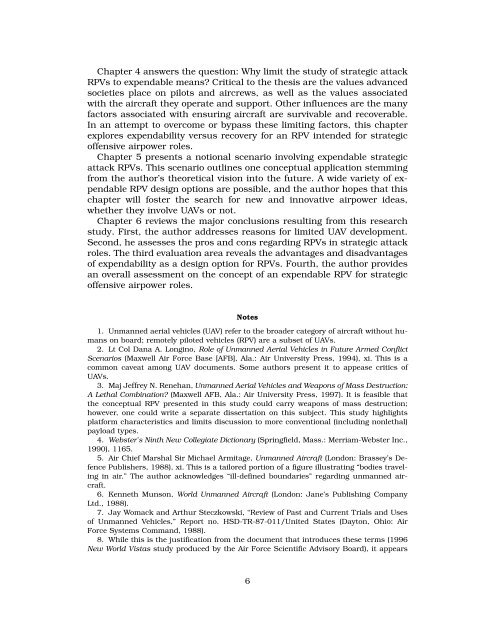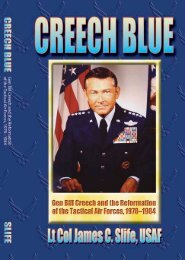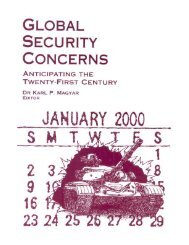Expendable Remotely Piloted Vehicles for Strategic Offensive ...
Expendable Remotely Piloted Vehicles for Strategic Offensive ...
Expendable Remotely Piloted Vehicles for Strategic Offensive ...
You also want an ePaper? Increase the reach of your titles
YUMPU automatically turns print PDFs into web optimized ePapers that Google loves.
Chapter 4 answers the question: Why limit the study of strategic attackRPVs to expendable means? Critical to the thesis are the values advancedsocieties place on pilots and aircrews, as well as the values associatedwith the aircraft they operate and support. Other influences are the manyfactors associated with ensuring aircraft are survivable and recoverable.In an attempt to overcome or bypass these limiting factors, this chapterexplores expendability versus recovery <strong>for</strong> an RPV intended <strong>for</strong> strategicoffensive airpower roles.Chapter 5 presents a notional scenario involving expendable strategicattack RPVs. This scenario outlines one conceptual application stemmingfrom the author’s theoretical vision into the future. A wide variety of expendableRPV design options are possible, and the author hopes that thischapter will foster the search <strong>for</strong> new and innovative airpower ideas,whether they involve UAVs or not.Chapter 6 reviews the major conclusions resulting from this researchstudy. First, the author addresses reasons <strong>for</strong> limited UAV development.Second, he assesses the pros and cons regarding RPVs in strategic attackroles. The third evaluation area reveals the advantages and disadvantagesof expendability as a design option <strong>for</strong> RPVs. Fourth, the author providesan overall assessment on the concept of an expendable RPV <strong>for</strong> strategicoffensive airpower roles.Notes1. Unmanned aerial vehicles (UAV) refer to the broader category of aircraft without humanson board; remotely piloted vehicles (RPV) are a subset of UAVs.2. Lt Col Dana A. Longino, Role of Unmanned Aerial <strong>Vehicles</strong> in Future Armed ConflictScenarios (Maxwell Air Force Base [AFB], Ala.: Air University Press, 1994), xi. This is acommon caveat among UAV documents. Some authors present it to appease critics ofUAVs.3. Maj Jeffrey N. Renehan, Unmanned Aerial <strong>Vehicles</strong> and Weapons of Mass Destruction:A Lethal Combination? (Maxwell AFB, Ala.: Air University Press, 1997). It is feasible thatthe conceptual RPV presented in this study could carry weapons of mass destruction;however, one could write a separate dissertation on this subject. This study highlightsplat<strong>for</strong>m characteristics and limits discussion to more conventional (including nonlethal)payload types.4. Webster’s Ninth New Collegiate Dictionary (Springfield, Mass.: Merriam-Webster Inc.,1990), 1165.5. Air Chief Marshal Sir Michael Armitage, Unmanned Aircraft (London: Brassey’s DefencePublishers, 1988), xi. This is a tailored portion of a figure illustrating “bodies travelingin air.” The author acknowledges “ill-defined boundaries” regarding unmanned aircraft.6. Kenneth Munson, World Unmanned Aircraft (London: Jane’s Publishing CompanyLtd., 1988).7. Jay Womack and Arthur Steczkowski, “Review of Past and Current Trials and Usesof Unmanned <strong>Vehicles</strong>,” Report no. HSD-TR-87-011/United States (Dayton, Ohio: AirForce Systems Command, 1988).8. While this is the justification from the document that introduces these terms (1996New World Vistas study produced by the Air Force Scientific Advisory Board), it appears6






